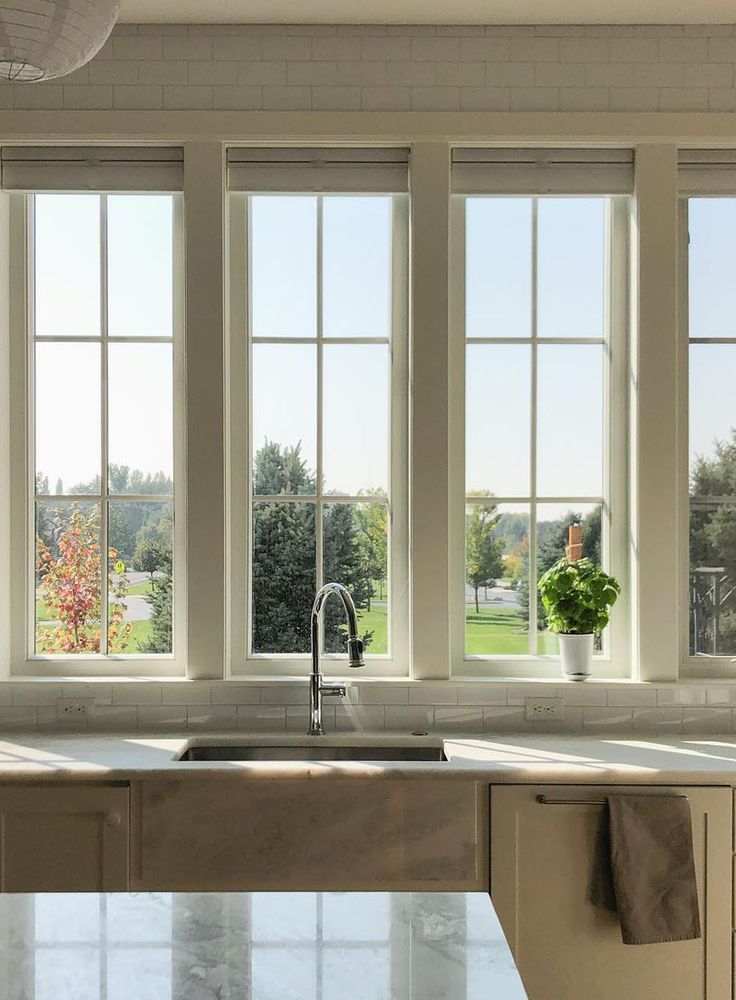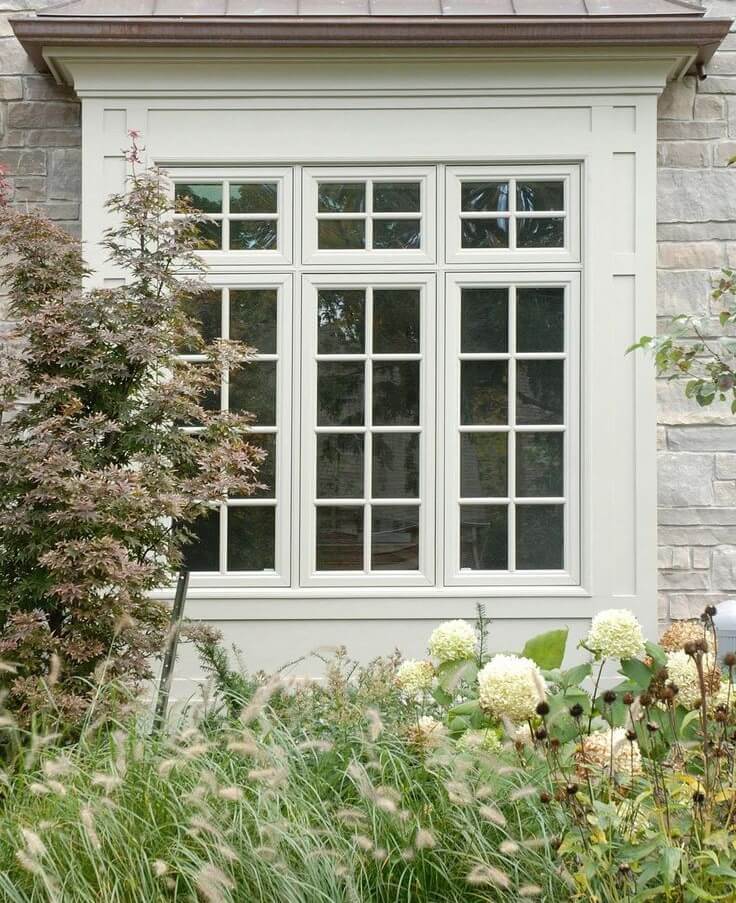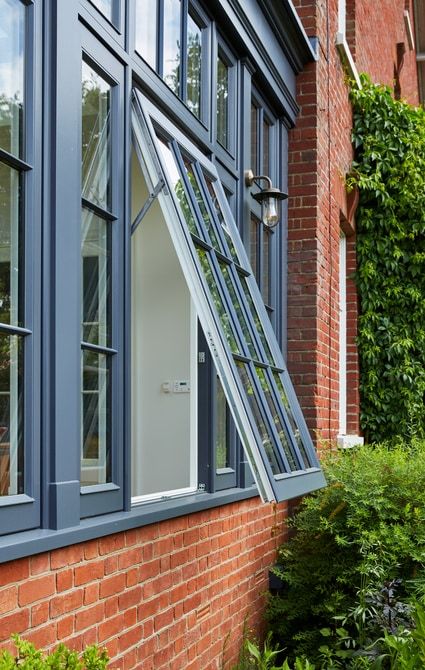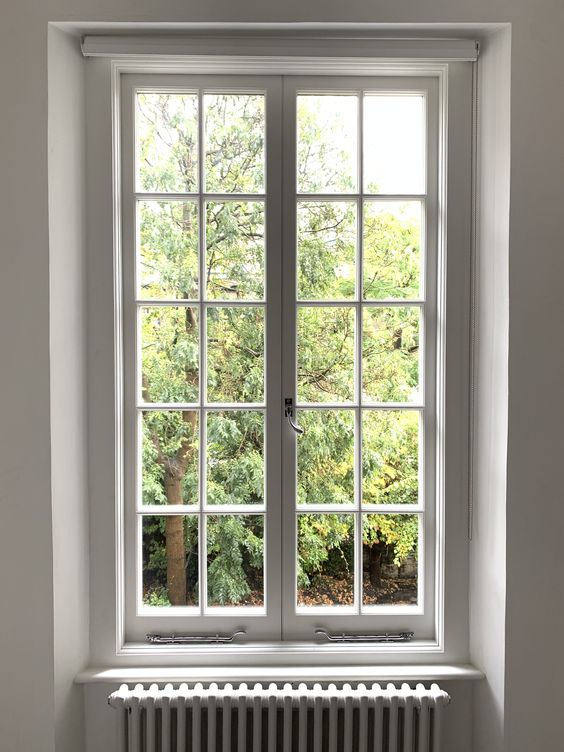Casement windows enjoy well-deserved popularity in traditional and modern homes alike. This type of window attaches to the frame by hinges and opens outwards by a crank.
Casement windows come in a large variety of types and materials to suit every architectural style. You can choose between the basic single-casement window with one side-hung panel, classic French casement windows with two panels, or stylish bay windows that allow you to enjoy your view to the fullest.
A traditional two-panel side-hung window is probably the most common type of casement window, but casement windows with top- and bottom-hung panels are also popular. A top-hung window panel on a casement window can protect your interior from the rain, while a bottom-hung hopper panel is convenient for upper-floor rooms and apartment buildings.
At WoodBeeLtd, we create exquisite bespoke wooden casement windows for every home. Our windows unite beauty, durability, security, and energy efficiency. Classic and timeless, quality casement windows add value to your property while elevating your style.
Table of Contents
Benefits of Casement Windows
Casement windows are one of the oldest window styles in Britain. This type of window dates back to medieval times, long before sash windows gained favour in British homes. Although various window styles are available today, many homeowners still choose casement windows.
There are many excellent reasons for the enduring popularity of casement windows in the UK. Let’s discuss the main benefits of this type of window, why you may consider casement windows for your home, and which variety might best suit your decor.
Energy Efficiency
Quality casement windows are highly energy efficient. Compared to other window types, casement styles have a tighter seal, so a double-glazed casement window provides superb insulation.
You close a casement window by pressing the window tightly against the frame, which reduces any air leaks to almost zero. Thus, casement windows are the most energy-efficient windows after picture windows, which don’t open at all.
Ventilation
When considering insulation vs ventilation, casement windows offer you the best of both worlds. Casement window frames can include trickle vents, which are slits in the frame with a cover that you can open and close. An open trickle vent promotes better air circulation, helps remove excess moisture, and prevents mould growth.
Casement windows work great for catching a refreshing side breeze since an open sash of a casement window funnels air into the room. This is a highly useful feature on hot days without much air movement.
Natural Light
Casement windows are champions at amplifying natural light. Unlike certain types of windows, casements can open fully, letting light and air stream into the room on fine-weather days. A wide casement window is perfect for showing off a gorgeous panoramic view.
You can also opt for the types of casement windows in which the top and bottom half open separately to fit weather conditions and your preferences.
Easy Operation
Casement styles are among the most user-friendly types of windows. They open and close effortlessly, and since they open outwards, they don’t take up any space inside the room.
Casement windows are also easy to clean. These windows have a basic mechanism that allows effortless access to all parts of the window, so casement window maintenance is a breeze. This is a major advantage of casement windows over other window types, like sliding windows, which may require removing panes for cleaning.


Energy Efficiency Features
All types of double-glazed casement windows provide excellent energy efficiency. The strong seal on all sides of a casement window’s frame reduces air leaks and prevents heat loss. However, you can add extra features to make your windows even better at energy conservation.
Low-E Glass
Low emissivity (Low-E) glass minimises the UV and infrared rays that penetrate your glass without reducing the amount of light your home enjoys. Low-E glass achieves this effect thanks to a microscopic, transparent heat-reflective coating. This coating reflects outdoor heat back outside and helps keep interior temperatures constant.
Low-E glass comes in two types: passive hard coats and solar control soft coats. Hard-coat options are more suitable for cold climates since they let more infrared rays in and help heat your interior. For moderate climates, soft-coat Low-E glass is usually the superior choice as it protects against UV rays better.
Multi-Point Locking System
Multi-point locking is another feature that can improve insulation. Multi-locks anchor your window more snugly to the frame and help prevent air leaks.
Multi-point locks also provide extra security. They deter burglars and reduce the risk of a break-in through windows. Many homeowners choose to install multi-point locking systems for their peace of mind.
Weather Stripping
Although casement windows offer superb insulation, you may still experience some drafts and air leaks in your home. Weather stripping can help resolve this issue by sealing all the vulnerable spots of your windows.
For sashes and window tops, you can choose metal caps that drive away rainwater. On the sides, you may install rubber window gaskets. You can also opt for foam weather stripping, which works great for containing air.
Casement Window Materials
Our casement windows are available in high-quality pine and timber. Each has its benefits, price range, and structural properties to consider. One of our experts can walk you through the differences to find the best one for your needs.
Natural wood is a timeless, long-lasting, and renewable material that provides excellent insulation. It’s more durable and provides better temperature control than other window frame materials.
Pine and Timber
Wood casement windows create a classic look that can be rustic or sophisticated, depending on the design you pick.
When you decide on a wood frame, you have two broad choices: softwoods and hardwoods. Softwoods originate in coniferous trees, usually pine. Because these trees grow fast, softwood timber is usually cheaper.
Hardwood timber comes from deciduous trees like oak, walnut, maple, mahogany, and teak. Timber casement windows use high-density woods that are stunningly beautiful and extremely durable.
Durability and Maintenance
Softwood and hardwood window frames will need repainting or re-sealing to keep them in prime condition. Both types can also last decades with proper maintenance. However, everything else being equal, hardwoods offer better durability.
Because hardwoods have a denser structure, they’re more resistant to fire, rot, and insect damage. They’ll usually stay in good-as-new condition longer and with less maintenance than softwoods. That’s why choosing top-quality hardwoods is often a smart investment, as you’re getting a window that will last you a lifetime and beyond. However, softwood may be a more practical option for some complex designs since it’s easier to work with than hardwood.
Styles and Designs
When opting for casement windows, you can choose from various styles and designs. You can also personalise your windows by selecting different colours and finishes. It’s important to consider your home’s architecture and the look you’re going for: quaint and cosy, elegant, rustic, or sharp and modern.
Traditional vs. Modern
If you’re going for the classic look, you should choose windows that blend in with your home’s traditional vibe. Old-fashioned casement windows offer a unique charm that makes them perfect for homes built in the Georgian, Victorian, and Edwardian styles.
Classic casement windows typically feature more ornate designs and softer lines. The colours usually pop to contrast with the building’s tones. You might choose light tones, richer earthy hues, or a bold shade like forest green or navy blue.
In contrast, modern casement windows usually show sharper, crisper lines that fit a more contemporary style. The colour may blend with the home’s tone so that the frame fades into the background — or add a dark accent for a dramatic effect.
Customisation
When designing casement windows, you have a lot of freedom in choosing details like colours and finishes. The hardware, locks, and window latches for casement windows are all customisable.
White or cream are classic choices for window frames and will look wonderful on almost any home, but darker shades can be very bold and elegant, especially if you choose a lighter exterior paint. You can also choose staining over painting to bring out your window frame’s beautiful natural wood grain.
You’ll also need to consider whether you want window grilles. Traditionally installed to hold multi-paned windows together, today’s grilles are mostly decorative and come in various square, rectangular, diamond, and rounded patterns.


